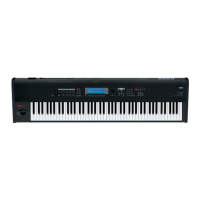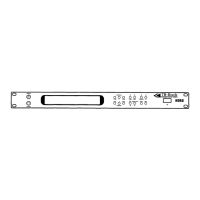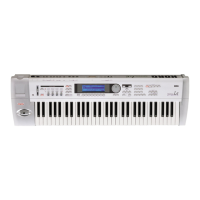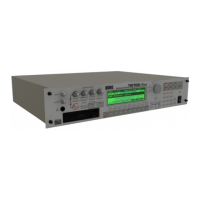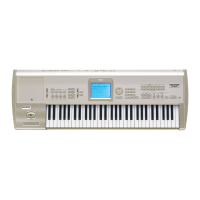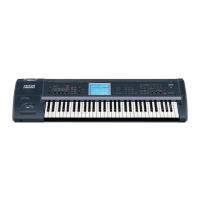12
Specifying the arpeggio patterns used in a
Combination
In Combination mode you can have two arpeggio pat-
terns assigned to different timbres and running simulta-
neously.
1
Press the [COMBI] key.
You’re in Combination mode. Make sure that the
display shows Combination P0: Play.
If a different screen is shown, press the [EXIT] key.
2
Select a combination.
3
Press the ARPEGGIATOR [ON/OFF] key (it will
light).
When you play the keyboard, the arpeggiator will
produce an arpeggio pattern such as an arpeggio
(broken chord) or backing riff.
Normally, when you select a new combination, the
arpeggiator will use the arpeggiator patterns that were
saved with that combination. If you want to keep the
current arpeggio patterns running while you switch
combinations, you can change this setting in “Auto
Arpeggiator” (Global P0: Basic Setup, Basic page).
(
☞OG p.90)
Making arpeggiator assignments
4
Press the Arpegg. A tab or Arpegg. B tab.
5
Check the “Arpeggiator Run” field for the arpeg-
giator(s) that you want to use.
When you turn on the ARPEGGIATOR [ON/OFF]
key and play the keyboard, the arpeggiator(s) speci-
fied by the “Arpeggiator Run” setting will operate
for the timbres you specify in “Timbre Assign.”
6
In the “Timbre Assign” area, check the timbres to
which arpeggiators A and B are assigned.
In the example shown here, arpeggiator A is
assigned to timbres 2 and 4, while arpeggiator B is
assigned to timbres 3 and 5.
Selecting an arpeggio pattern and specify-
ing how it will play
7
To make settings for arpeggiator A, press the
Arpegg. A tab. To make settings for arpeggiator B,
press the Arpegg. B tab.
8
Select an arpeggio pattern, adjust the tempo, and
specify how it will play.
For details about these settings, refer to steps 5–14
on p.10.
The ARPEGGIATOR [ON/OFF] key, ARPEGGIATOR
[TEMPO] knob, ARPEGGIATOR [GATE] knob, and
ARPEGGIATOR [VELOCITY] knob apply to both
arpeggiators A and B.
Saving your edited data
Your edits will disappear if you select a different com-
bination or turn off the power. If you want to keep the
changes you made, you’ll need to Write or Save the
data. For details on writing and saving, refer to OG
p.114 and p.117.
The arpeggiators in Sequencer mode and
Song Play mode
In addition to the Program mode and Combination
mode explained here, you can also use the arpeggiators
in Sequencer mode and Song Play mode. As in Combina-
tion mode, you can have two arpeggio patterns running
simultaneously. The arpeggiators can be synchronized
with the song playback, and in Sequencer mode you can
also record the notes generated by the arpeggiators.
Creating a user arpeggio pattern
You can create your own arpeggio patterns. For details,
refer to OG
p.98.
VA LVE FORCE
VOLUME VALUE
PROGCOMBI
SAMPLINGSEQ
GLOBALS.PLAY
COMPAREMEDIA
A
B
INPUT TRIM
ASSIGNABLE 1
LPF CUTOFF
ULTRA BOOST
ASSIGNABLE 2
RESONANCE/HPF
TUBE GAIN
ASSIGNABLE 3
EG-INTENSITY
OUTPUT LEVEL
ASSIGNABLE 4
EG-RELEASE
ON/OFFREALTIME CONTROLS
1
1
2
2
2
1
8
4, 7
1
2
8
Combination
Select
5
6

